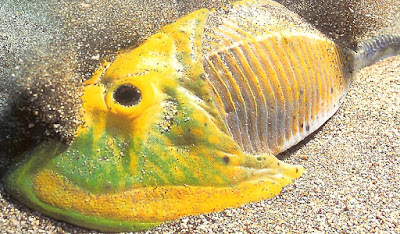Ammonites
Ammonites were carnivors, their diet consited of small fish, munching them with a powerful beak, as well as other small marine life. Ammonites were popular on larger carnivorous marine life's menu's though, such as icthyosaurs, but they would either have to pull it out from the shell, or have jaws powerful enough to crush it.
Wonder how Ammonites move? Well, they moved by squeezing water and expelling it out, meaning they could dart in all different directions, making it hard for preadators. Ammonites didn't sink to the ocean floor because their shell was filled with chambers of water and gas, making them buoyant.
Interesting Facts:
- Ammonites closest living relative are the rare, deep Pacific dwelling Nautilus.
- Ammonite fossils are commonly found in rocks, their distinctive curly shell giving them away.
- Ammonites all layed eggs, the males mated with the females, then the females placed the eggs on a hard surface until they hatched.
Basilosaurus
Basilosaurus wasn't a Dinosaur or Marine Reptile, it was a Whale; a mammal. It lived from about 40-36 million years ago in the Late Eocene period and weighed about 50-60 tonnes. Females could grow to 15m long and the males 18; though larger ones may have grew to 20. Basilosaurus was very long but suprisingly had a small head for it's size.Basilosaurus was a carnivore, eating meat. It ate fish, squid, sharks and somtimes maybe even Dorudon calves when they were born.
Basilosaurus was first discovered in 1843 in Louisiana, USA. Basilosaurus has also been found in Fayum deposits in Egypt. In the desert of Eygypt there is a place called 'The Valley Of The Whales', where whale skeletons erode out of the sand. Two kinds of whales are found there, Basilosaurus being one of them. When Basilosaurus was first discovered, it was mistaken as a sea serpent!
Interesting Facts:
- Basilosaurus was one of the first giant whales.
- Basilosaurus was closely related to Dorudon.
- Basilosaurus, as well as Dorudon, had a pair of tiny back legs that were used for mating. Whales now haven't got these legs.
- Basilosaurus, like all whales, started off as small, land-dwelling mammals.
Cephalaspis
Cephalaspis were peaceful herbivores, feeding off algae. They would suck the algae up through their jawless mouth. On the other hand, predators were a huge problem, sea scorpions such as Brontoscorpio, and large artropods such as Pterygotus, all fed on Cephalaspis. But Cephalaspis had one advantage on it's side, they used a very different way of sensing danger. Cephalaspis used an early warning system, just above the bottom of their headgear were some special scent glands, these glands would detect even the smallest vibrations in the water, and they would swim away.
Reproduction was a whole different aspect from the life of a Cephalaspis. They would first mate, and then the females would make a long journey to a spawning pool. Using navigation and memory, Cephalaspis would make it to the spawning pool and lay their eggs. The eggs were small and were layed quickly, and then they would make the journey back to the open ocean.
Interesting Facts:
- Believe it or not, Cephalaspis were actually an ancestor of us.
- Due to their headgear, Cephalaspis couldn't swim very fast for long, and would have to rest frequently.
Liopleurodon
Liopleurodon were massive carnivores eating any kind of meat the sea could throw at them. Such as icthyosaurs, such as opthalmosaurus, plesiosaurs, such as cryptoclidus, hyobodus sharks and more, crushing then easily with it's powerful jaws.
Liopleurodon lived from about 165 to 150 million years ago in the Late Jurassic period. Most Liopleurodon fossils have been found in the UK and Germany.
Interesting Facts:
- Liopleurodon skulls show that it could sample the water sterio through it's nostrils, just like a tracking device to track down it's next meal.
- Liopleurodon's teeth were twice as long as Tyrannosaurus'. Source

What do jellyfish eat?



No comments:
Post a Comment